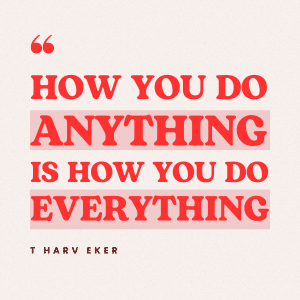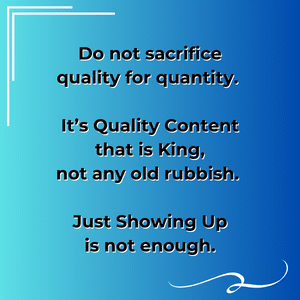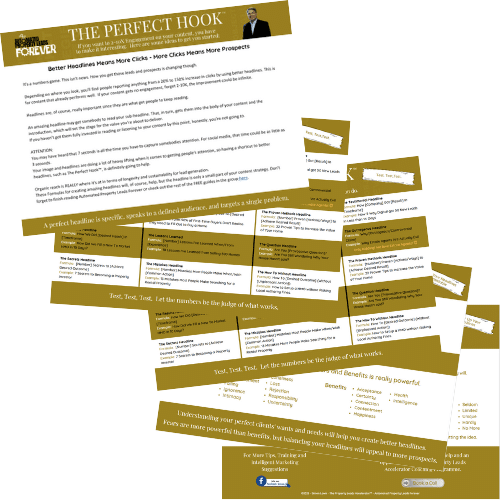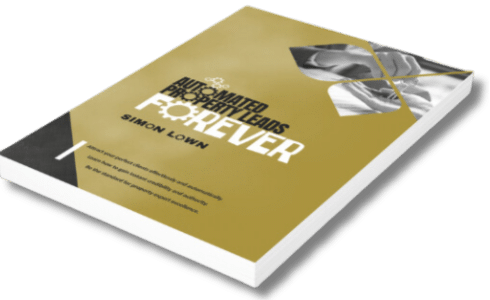You need a few things in place before you can start writing amazing property content. It’s not that your freestyle content will be bad; it’s more that it won’t be the best it can be, and you may not be able to sustain it long-term.
Before we go any further, I want to clarify that I’m talking about expert content here, not property listings. The theme here is creating content that positions you as an expert and builds trust in your brand.
I don’t claim to be the world’s best writer or know all there is about creating literary masterpieces, but I do know how to figure out what people want.
The best bit is, so do you.
If you want to be seen as a property expert and known as a trusted source of information, you must produce content. You can’t grow your brand without providing valuable information, whether it’s books, blogs, social media or videos.
You become the go-to expert when you create content people need and show up when they look for answers.

Once you know what you need to create and how you’ll go about doing it, your content goldmine will start to grow and allow you to:
- Attract your perfect prospects before your competitors know they exist
- Capture their contact details
- Nurture them until they’re ready to buy, sell, rent or invest.
With a few guidelines, you can start creating content that people want to consume and grow your business organically and at a much lower cost than others who must continually increase ad spend to keep the status quo.
Let’s get started.
Understanding Your Audience
The first thing you need is an audience to speak to. The audience you want to talk to is not the area you cover, an age range, the size of their pay packet or gender.
Instead, your audience should be defined by the challenges they will face and the outcomes they desire.
This way, you will know how to attract the people you can help.

Defining Your Niche
As a property professional, you may be able to help anyone who comes your way. That’s amazing and commendable. Sadly, it won’t benefit you when creating content.
The reason I suggest you switch from standard marketing demographics to solution-based content is that, well, you already know the answer.
- Everybody is unique.
- Their circumstances are all slightly different.
- They have different priorities.
- Some have an urgency and need speed, while others don’t.
- Some are well-informed, while others need more details.
- As a result, some will need more guidance than others.
If you try and create content for Mr & Mrs Smith with 2.4 children, 80k a year household income, who like to holiday in the south of France, you’re not going to be speaking to a large audience who need the same problem-solving but don’t identify with your avatar.
Maybe you realise this, and in your next post, you write for the 20-somethings looking to get on the property ladder. Does that mean the 30 & 40 somethings will be attracted to the same content?
Define your content by the problems it solves, and you not only get around this issue but also align your content with what people will search for to get a solution.
Of course you can help anyone, but if you try to create content without a focused audience, you’ll attract nobody. Let the problems you solve and the answers you provide be your niche.
Research Trends and Keywords
Keywords are essential, but matching content with the searcher’s intent is more so.
You can use Search Engine Optimisation (SEO) tools to help find various keywords for your content, but it’s not necessary when starting your content goldmine.

By talking about the issues people will face and how to overcome them, your content will naturally include multiple relevant keywords. This is a good SEO strategy and will help Google show your content to people who need the answers you’ve provided.
Your experience of speaking with people daily and answering their questions should give you some insight into how people might search for the problems you’re solving with your expert content. If you aren’t sure, then the SEO tools can certainly help.
Crafting Compelling Headlines
Much of the heavy lifting is done by headlines and featured images when getting clicks from Google and social media.
Yes, your headline must be captivating, but for content that solves a specific problem, you don’t want to stray too far from the question.
Although Google analyses the content for context and to understand what it’s about, the headline and main keywords will still have an effect. The closer your headline matches Google’s analysis, the better. If your headline gets too far removed from your content, it might be considered spammy or irrelevant.
The great thing about using questions as your headline is that it’s difficult to misinterpret what you’ve written about.
Developing Engaging Content
You’ll need something to keep your readers engaged when creating your content.
Your audience will likely consume most of your content since they searched specifically for that answer. However, using all the available tools would be best to ensure you don’t lose them through boredom.
Tell Stories

Adding stories to your content will give you a thread to which you can keep coming back. Even if you must move away from the central theme to explain a detail or nuance of solving an issue, you can tie it back to your story and move on.
Where you can, it will always be better to incorporate your client’s stories into your content, but be sure you have permission to use names, etc. Privacy is a big deal. But you know that.
Using your client’s success stories and wins will allow your audience to connect with you and build rapport.
Add Your Beliefs
Your perspective and point of view is what makes you unique.
Adding your values and explaining why you hold particular views will make your content unique and build trust in your expertise.
Ideally, having your brand and personal values written along with your mission statement would be best. This will enable you to reference them more readily when writing.
If you have to have them printed and stuck on the pinboard next to your desk so that you can choose which is most relevant when trying to make a point, do that.
It’s handy to have a little reminder while you’re creating so that you don’t have to add it in later, where it might not feel so natural or flow as well.
Provide Value
If you’re not providing a lot of value, your content isn’t going to do very well.
Avoid selling your services at all costs.
When people are looking for answers, they do not want to read a pitch fest.

Share all the steps, processes, and pitfalls you can to demonstrate your expertise.
You should leave nothing out.
Covering the entire subject, warts and all, is a sign of a well-rounded professional with all-encompassing expertise. It positions you as a go-to expert since few are willing to do this.
If covering every aspect of a topic will make your content unnecessarily long, you can always use a Q&A format at the end of your post to make it easier for your readers to find the answers specific to their situation.
Use Visuals Effectively
Blog posts and social media rely heavily on visual content. For blogs, it breaks up the content and allows you to draw the reader’s focus to specific points. Social media is more about attracting clicks.
Even though I create featured images for all of my blogs, they will rarely be seen, if ever, in the Google search results. It doesn’t mean I will stop creating them, though. I still can and do use them on my socials.
If you’ve read any of my other posts about creating content, you’ll already know I use Canva for anything related to graphics.
Error Checking
You need to ensure that your content is not only factually correct but free of errors.
I use AI for fact-checking and Grammarly Pro for spelling, punctuation, and correctness.
Many tools are available to help ensure your content isn’t full of mistakes. Using at least one of them would be best—preferably more.
Despite what some say about a few spelling mistakes or some missing or improperly placed punctuation, it does have an impact, but not in a good way.

There is no place for sloppy work in the world of a property professional.
Optimising for SEO
I can’t write a post about creating amazing content without including a short section on SEO.

If you’re unsure about SEO, I urge you to read my post: What is SEO? A Stupid Simple Explanation.
While I talk about SEO being straightforward to get started with, which is true, it isn’t the whole story.
Each element of SEO by itself is pretty simple to understand, but there are hundreds of moving parts, all digital.
When it comes down to it, the more elements of SEO you can get right, the better your chances of showing up in the #1 spot of a Google search.
Leveraging Social Media
Social media is likely already a part of your business. Chances are that you’re not making the best use of it, though.
Businesses have very few desirable outcomes when it comes to social media usage.
You either want:
- A Lead
- A Sale
- or to Build Your Brand.
Anything beyond these outcomes is fluff. It doesn’t matter if you have a million followers and ten million likes if leads and sales are in short supply. Sure, it’s great for building your brand, but if you only operate within a 15-mile radius of your office, how many of those million followers will ever use your service?
Hmmm. 🤔
Ideally, your social content should get people off the platform and onto your website, where you can capture their details with your lead magnet or reach out to you directly. If you’re using an AI Chatbot, that step may be unecessary, but either way, you need to capture lead info at the earliest opportunity.
Social media gets much easier to create engaging content for when you have something to promote other than your latest instruction or offer.
The tools available to repurpose your long-form content into shorts, reels, and memes are improving almost daily. Not having the time to “manage” social media will soon be an excuse you’ll be hard-pressed to defend.

The Humanity Behind the Brand
One of the most essential elements of social media is the social part. Treat your audience as a community. Ask them questions and find out what they need from you rather than making assumptions.
Conversation is critical to demonstrating your understanding and willingness to share your expertise.
There are many types of posts you can use on social media that will help you engage more with your audience.
Here is the list of posts you can use for social variety from my book Automated Property Leads Forever:
- Engagement Posts
- Product Posts
- News or Trending Posts
- Teasers for Blog Posts – who knew?
- Competitions
- Screenshot Posts
- Infographics
- Personal Photo Posts
- Workplace and Behind-the-Scenes Posts
- Videos (surely not!)
- Memes
- User/fan-Generated Content
- Stories
- Interactive Content
- Livestreams
- Polls
- Questions
- Quotes
If you only ever post your latest offer or instruction, this list of post types will add a breath of fresh air to your social media.
Don’t pick one or two; try them all. And not just once. Use them every month. If nothing else, your feed will be the most interesting to browse in your area.
Social Tip
The final tip for social media is to create a series of #BrandedHashtags. This will make your content searchable and easily findable if somebody is a fan of your brand.
Social media is a vast topic, so I’ll leave it there for this post. There is much to learn and so little room here. I’ll be doing a more in-depth social post in future. Watch this space.
If you struggle with making time to manage your social channels, it is worth spending a few quid to get some help. If your social media is doing well, it will positively impact the SEO for your content.
It would be an expensive mistake to ignore it. If you don’t get organic reach, your only alternative is paying for it.
Consistency is Key
It doesn’t matter whether you want to get more views on Facebook, YouTube, or your blogs; consistency is one thing they all have in common.
If your posting schedule is erratic, you’ll struggle to gain traction.
It is far more critical to be consistent than to pump out vast volumes of content. Posting high-quality content once a day on Facebook is better than creating three in one day and then missing the next few days.
Creating a content list, a posting schedule, and a social media plan are essential parts of SEO.
What Level of Consistency?
Without consistency, you’ll find everything that much harder.
As to the frequency you should use, that depends on the platform.
For your blog, I would suggest that once per week should be the minimum. This is simply because, at the time of writing, a Google My Business post update lasts for seven days, so you’ll always have fresh content on your GMB listing.

The algorithms for social platforms are continually changing and are different for each. What worked last month might not work next month, so you’ll need to find sources of information that include the experience of more than one influencer, for example.
A good source of information would be the tools that schedule your content, such as Hootsuite, Buffer, or Sprout Social.
Since these platforms cater to thousands of users daily, they can analyse and report on what works best for each platform.
Measuring Success
To improve your content over time, you’ll need some measure of its performance.
The easiest way is to ensure the Facebook (Meta) Pixel and Google Analytics work on your website. They are both free to use and will help you understand what works and what doesn’t.
Even if you don’t plan on running Facebook Ads right now, you should still install the FB Pixel since it will track website visitors for up to 6 months, which will be helpful when you decide to start retargeting ads. Waiting until you begin running retargeting ads to install means you’ll have no historical data.
I discuss measuring your content strategy here: How to Measure Your Content Strategy Success and Boost Results.
The critical thing to remember when monitoring your content is that you won’t get all the answers from the numbers. Sometimes, you have to ask people what they think.
Start Writing Amazing Property Content Today
There you have it; if you want to write amazing property content to attract hot, qualified prospects to your business, you now have a starting point.
Is there more to it? Yes, of course. Isn’t there always?
What’s important is that you get started. Improvement along the way is inevitable.
If you follow this outline, your content will be better than 99% of property experts showing up online.
To write amazing property content, you must:
- Understand Your Audience
- Define Your Niche
- Research Trends and Keywords
- Craft Compelling Headlines
- Develop Engaging Content
- Tell Stories
- Add Your Beliefs
- Provide Value
- Use Visuals Effectively
- Error Check
- Optimise for SEO
- Leverage Social Media
- Be a Human
- Be Consistent
- Find the correct number of posts required per platform
- Measure Success
- Start Today
If you want to know more about creating expert content and getting leads with automation, check out my other posts. There is even more in my book, Automated Property Leads Forever. If that still isn’t enough, I am available for coaching.
I’d recommend you start with the book. I’ll be here if you still want to discuss the coaching after you’ve read it.
I’d wish you luck, but with a plan and perseverance, you won’t need it.













